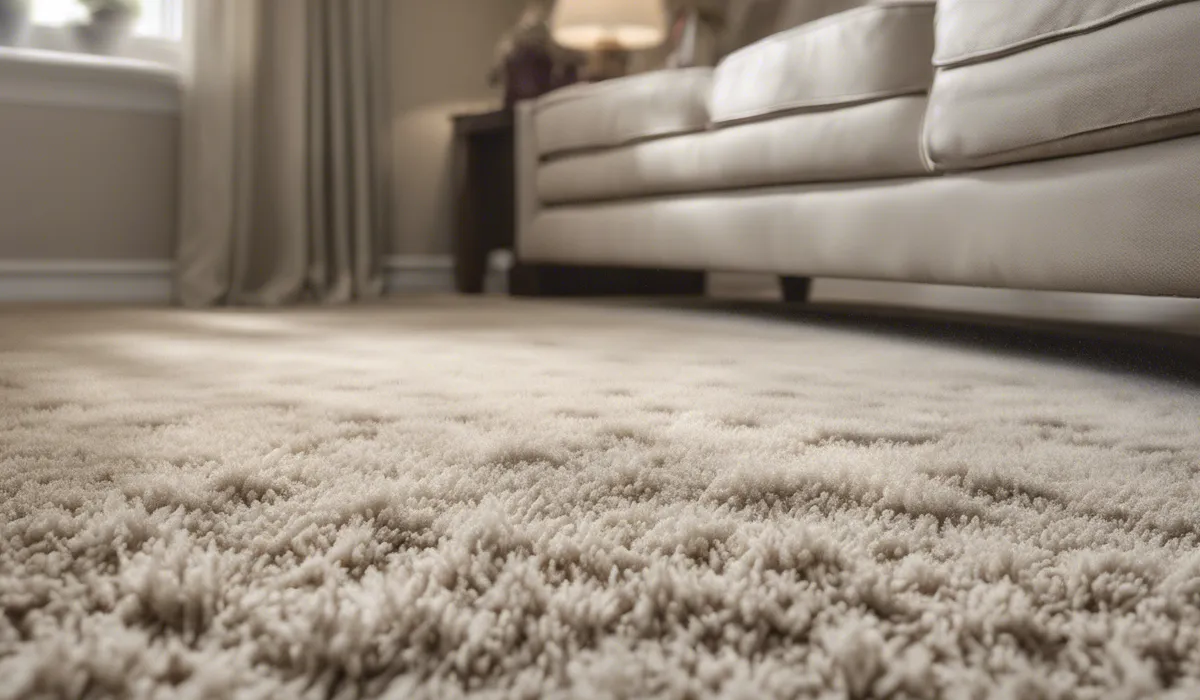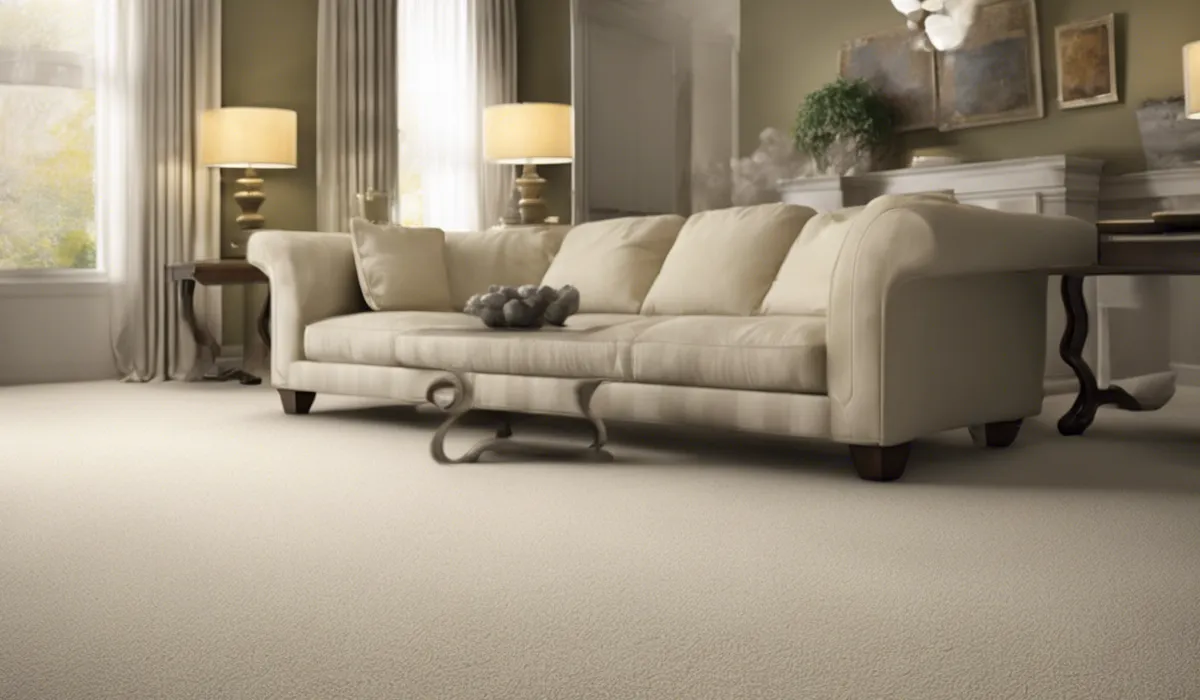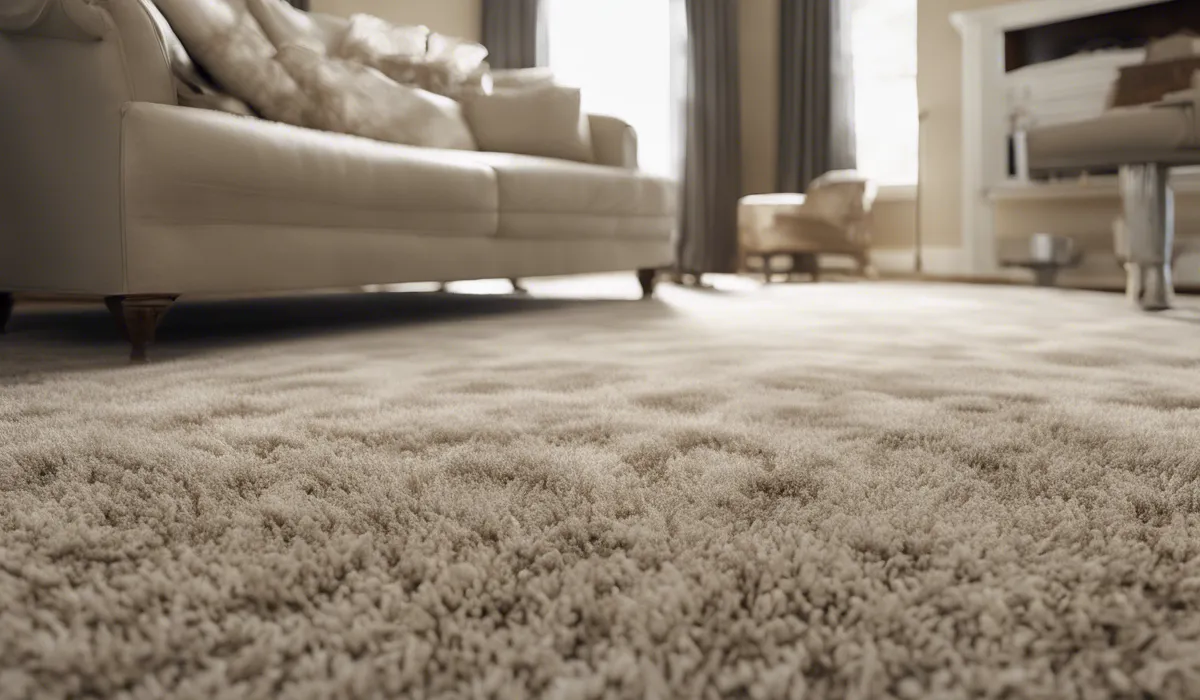Vinegar solution (one part vinegar to one part water) can kill mold and mildew in carpet. Spray generously, let sit, and then blot dry. For persistent issues, a fungicidal carpet cleaner or a mixture of baking soda and hydrogen peroxide may be required.
Causes and Identification of Mold and Mildew in Carpet

Difference Between Mold and Mildew
Mold and mildew are fungi that thrive in moist environments. While they may seem similar, they are different in appearance and the places they grow. Mold is usually black, green, or red and has a fuzzy texture.
It often grows beneath the surface of materials. Mildew, on the other hand, is typically white or gray and grows on the surface, making it easier to clean.
Common Causes of Mold and Mildew
Carpets can become breeding grounds for mold and mildew when exposed to moisture. Common causes include spills, high humidity, and water damage from leaks or flooding.
Carpets in basements or bathrooms are particularly at risk due to the higher moisture levels in these areas.
Health Risks Associated with Mold and Mildew
Exposure to mold and mildew can lead to health problems such as allergies, respiratory issues, and skin irritation.
Those with asthma or compromised immune systems are especially at risk. It is essential to address mold and mildew issues promptly to protect your health.
Signs and Symptoms of Mold and Mildew Presence in Carpets
Indicators of mold and mildew in carpets include a musty smell, visible growth, and dampness.
Allergic reactions or respiratory problems when in the room can also signal their presence. If you suspect mold or mildew, inspect your carpet closely for signs of these unwelcome guests.
Natural and Chemical Solutions to Remove Mold and Mildew

Vinegar and Baking Soda Method
A vinegar solution, made by combining equal parts water and vinegar, can effectively kill mold and mildew in carpets.
Simply spray the mixture generously onto the affected area, let it sit to penetrate, and then blot it dry. For an additional cleaning boost, sprinkle baking soda over the treated area, let it sit, and vacuum it up after a few hours.
Hydrogen Peroxide Treatment
Hydrogen peroxide acts as a gentle bleach and can kill mold spores. Apply a 3% hydrogen peroxide solution directly to the moldy areas of the carpet, allow it to sit for about 15 minutes, and then clean with a steam vacuum or blot the area dry.
Commercial Mold and Mildew Removers
There are many commercial products designed to tackle mold and mildew. When selecting a product, choose one that is specifically formulated for carpets and follow the instructions carefully.
Ensure the space is well-ventilated during use to protect your health and safety.
Role of Professional Carpet Cleaning Solutions
For severe infestations or large areas, professional carpet cleaning may be necessary. These services use powerful equipment and solutions to remove mold and mildew, restoring the carpet to a safe and clean state.
Safety Precautions When Using Chemicals
Always exercise caution when using chemical solutions. Wear gloves, protective eyewear, and a mask, and ensure the area is well-ventilated.
It is important to keep children and pets away from the area until the carpet is completely dry and aired out.
Preventative Measures and Maintenance Tips

Proper Ventilation and Humidity Control
Maintaining good air circulation and keeping humidity levels below 50% can prevent mold and mildew growth.
Use dehumidifiers and air conditioners to manage moisture and ensure that rooms with carpets are well-ventilated.
Regular Carpet Cleaning and Vacuuming Practices
Regular vacuuming and deep cleaning of carpets can remove potential mold and mildew food sources like dirt and organic debris.
Addressing stains and spills immediately prevents moisture from seeping into the carpet padding, where mold can start to grow.
Importance of Immediate Action After Spills and Water Exposure
When spills occur, blot the liquid as quickly as possible and use a fan or dehumidifier to dry the area thoroughly. In the case of flooding, it may be necessary to remove the carpet to prevent mold growth.
Recommendations for Carpet Padding to Prevent Mold Growth
Selecting the right carpet padding is crucial for preventing mold. Pads with antimicrobial properties or those made from moisture-resistant materials can provide an extra layer of protection against mold and mildew.
When to Consider Replacing Your Carpet?
If mold and mildew have deeply penetrated your carpet and the underlying padding, it may be time to replace it.
Continual health symptoms or persistent odors are signs that the current carpet may be beyond saving.
FAQs About What Kills Mold and Mildew in Carpet
Can vinegar solution kill mold and mildew in carpet?
Yes, a vinegar solution made of equal parts vinegar and water can be used to kill mold and mildew in carpets.
What is the process for using vinegar to remove mold from carpet?
To remove mold using vinegar, spray the solution generously onto the affected area, let it sit, and then blot the area dry.
Are there any commercial products that can kill mold in carpets?
Yes, fungicidal carpet cleaners are commercially available and formulated specifically to kill mold in carpets.
What natural remedies can be used for persistent mold and mildew in carpets?
For persistent mold issues, a mixture of baking soda and hydrogen peroxide can be used as a natural remedy.
Is it safe to use hydrogen peroxide on carpets to kill mold?
Hydrogen peroxide can be used on carpets, often mixed with baking soda, but it’s important to test it on a small, inconspicuous area first to ensure it doesn’t bleach the carpet.
Final Thoughts
A vinegar solution, mixed equally with water, is effective for killing mold and mildew in carpets.
Generously spray the affected area, allow it to sit, and then blot it dry. Persistent mold may necessitate the use of a fungicidal carpet cleaner or a concoction of baking soda and hydrogen peroxide for complete eradication.
